A simplified 3D liver microsphere tissue culture model for hepatic cell signaling and drug-induced hepatotoxicity studies
Corrigendum in: /10.3892/ijmm.2023.5234
- Authors:
- Ying Zhu
- Qiong Shi
- Qi Peng
- Yue Gao
- Ting Yang
- Yu Cheng
- Hao Wang
- Yetao Luo
- Ailong Huang
- Tong‑Chuan He
- Jiaming Fan
-
Affiliations: Ministry of Education Key Laboratory of Diagnostic Medicine, School of Laboratory Medicine, Chongqing Medical University, Chongqing 400016, P.R. China, Department of Biostatistics, School of Public Health and Management, Chongqing Medical University, Chongqing 400016, P.R. China, Key Laboratory of Molecular Biology for Infectious Diseases of The Ministry of Education of China, Institute for Viral Hepatitis, Department of Infectious Diseases, The Second Affiliated Hospital of Chongqing Medical University, Chongqing 400037, P.R. China, Molecular Oncology Laboratory, Department of Orthopedic Surgery and Rehabilitation Medicine, The University of Chicago Medical Center, Chicago, IL 60637, USA - Published online on: August 21, 2019 https://doi.org/10.3892/ijmm.2019.4321
- Pages: 1653-1666
-
Copyright: © Zhu et al. This is an open access article distributed under the terms of Creative Commons Attribution License.
This article is mentioned in:
Abstract
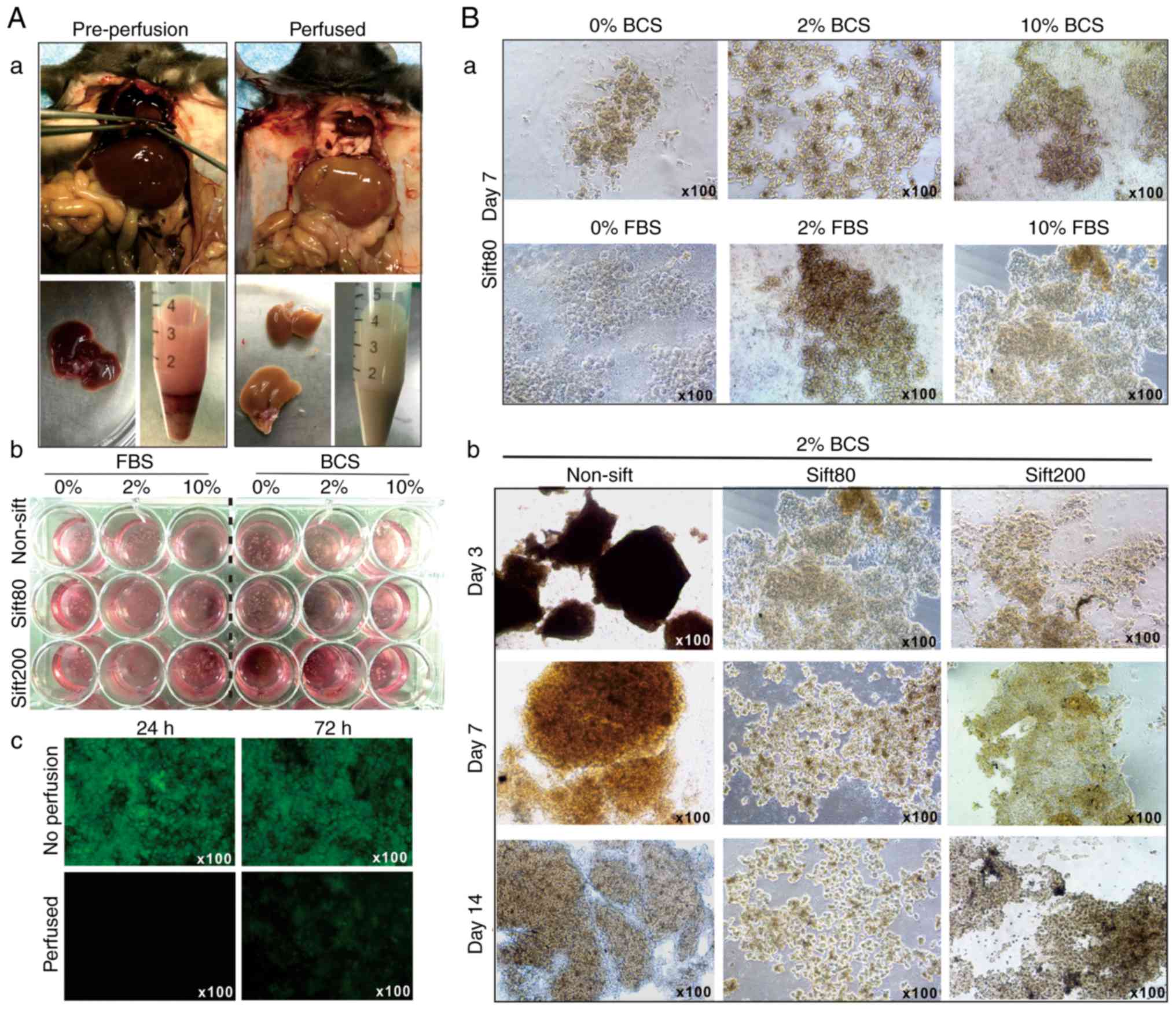 |
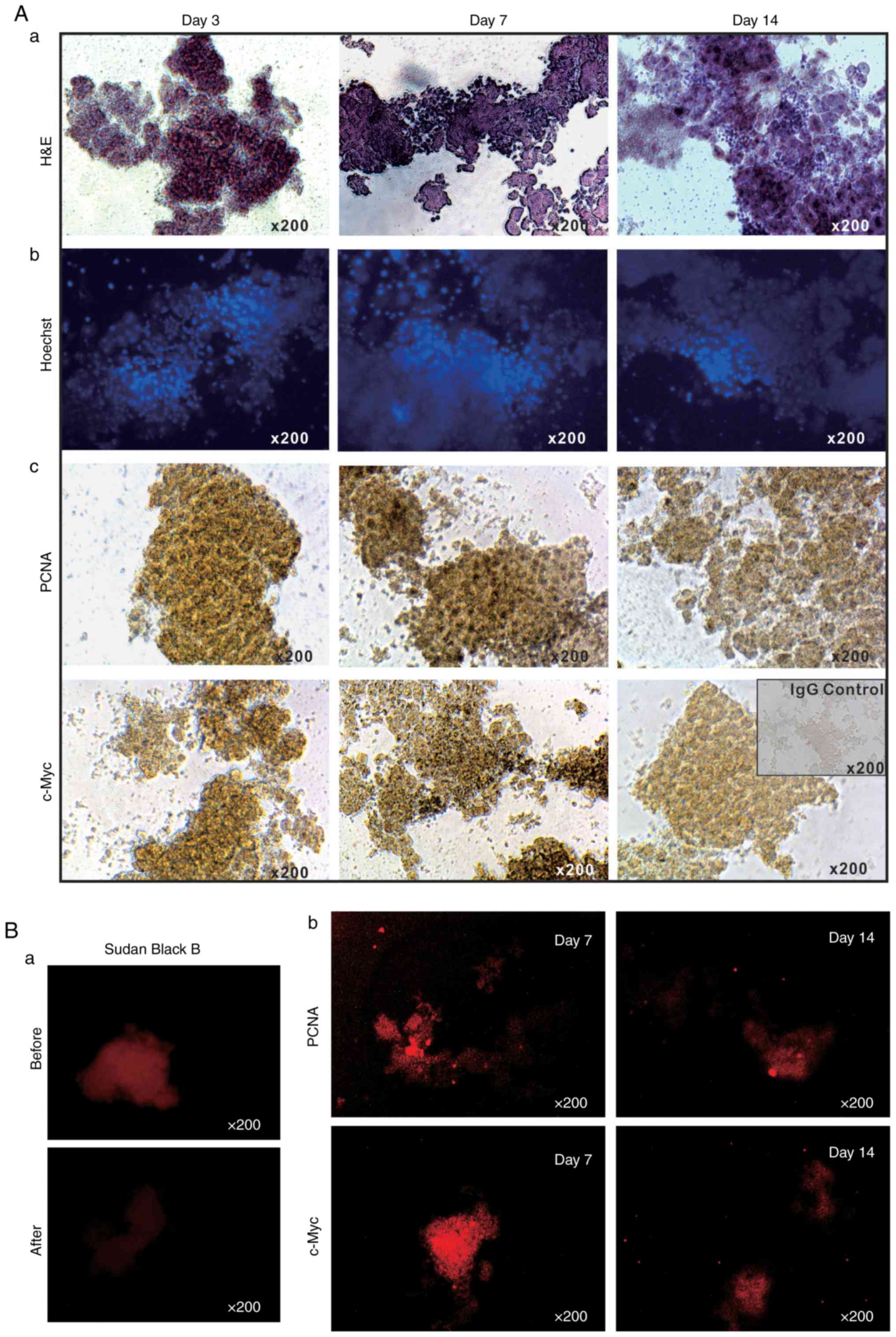 |
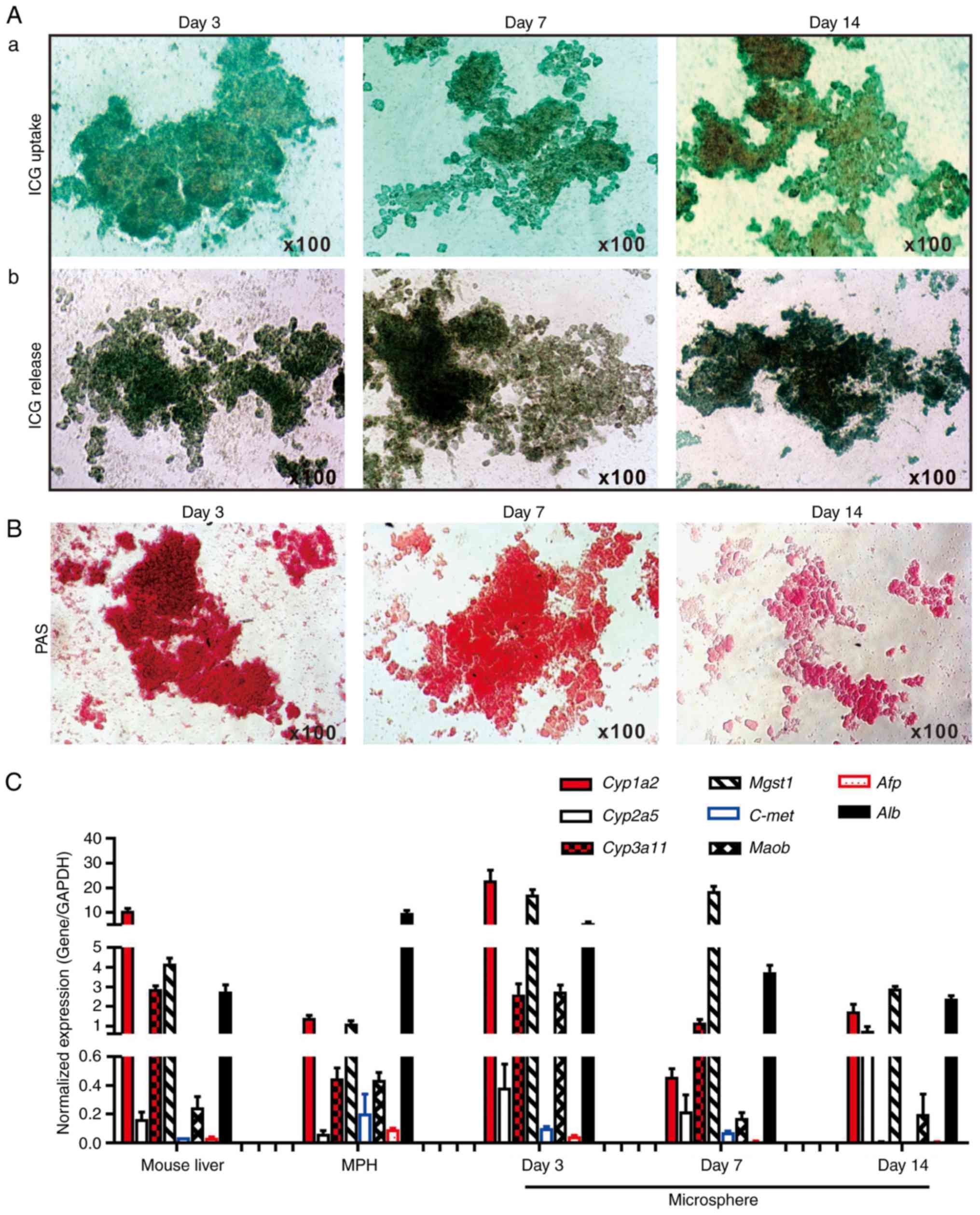 |
 |
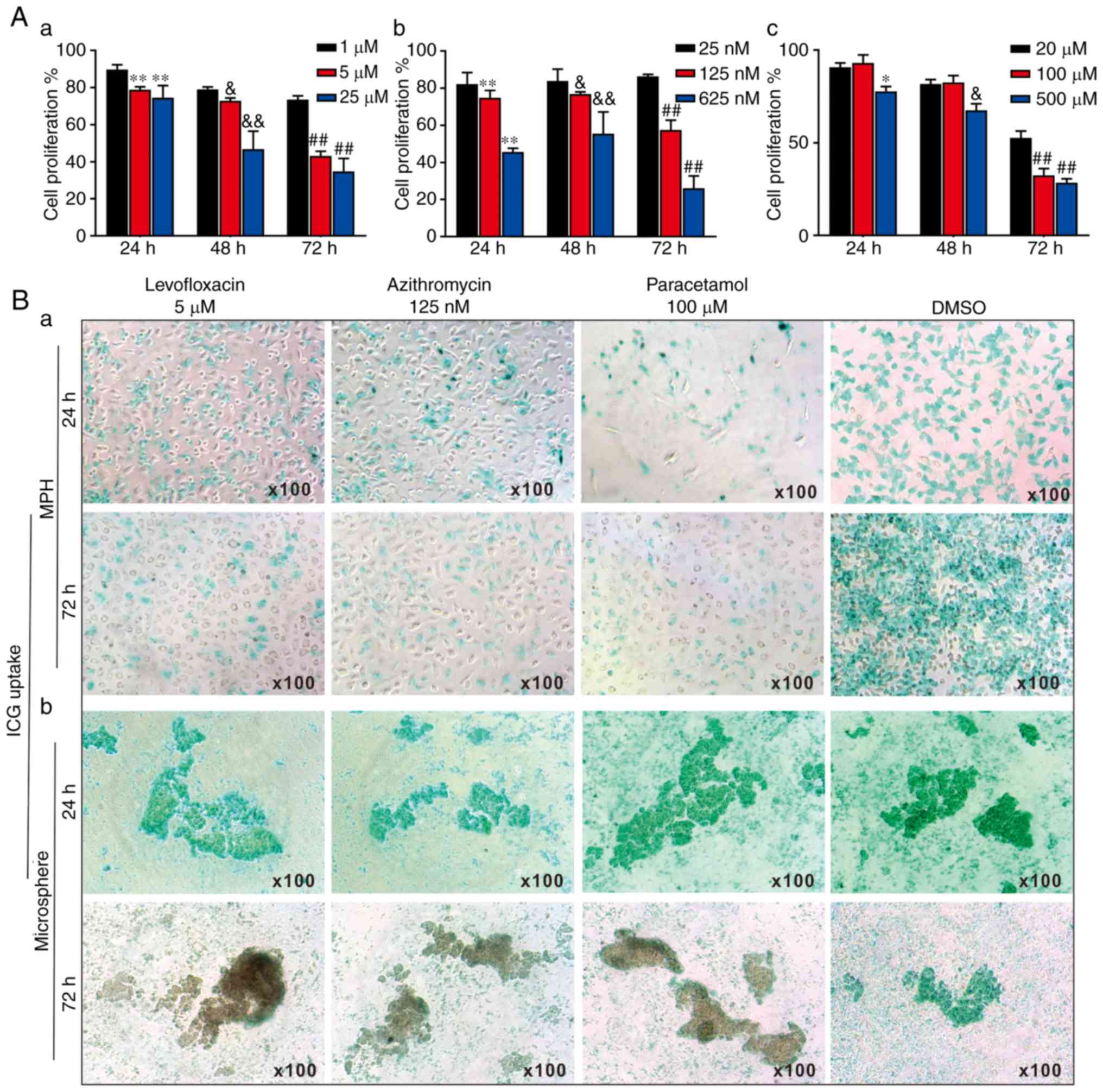 |
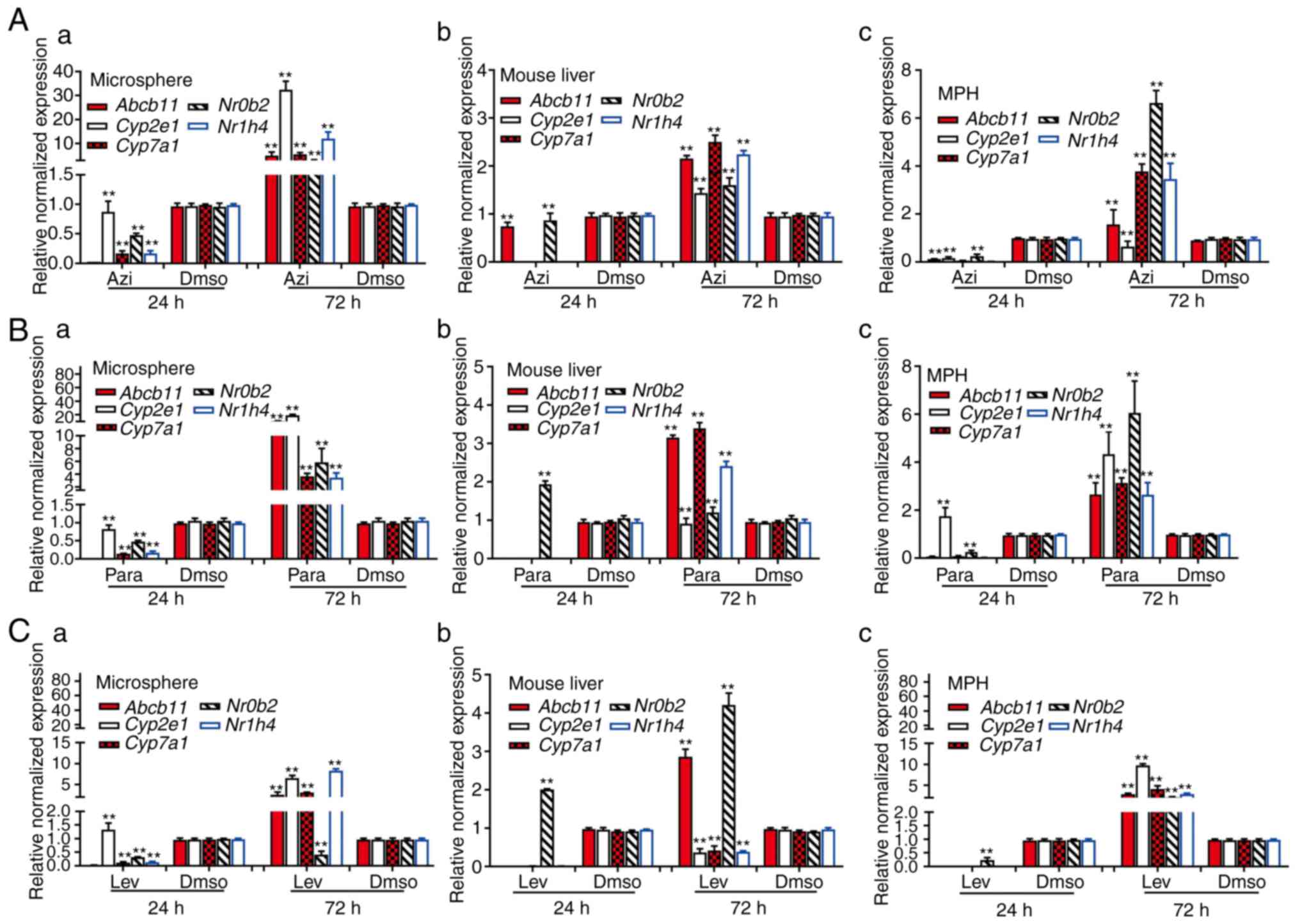 |
|
Beckwitt CH, Clark AM, Wheeler S, Taylor DL, Stolz DB, Griffith L and Wells A: Liver 'organ on a chip'. Exp Cell Res. 363:15–25. 2018. View Article : Google Scholar : PubMed/NCBI | |
|
Si-Tayeb K, Lemaigre FP and Duncan SA: Organogenesis and development of the liver. Dev Cell. 82:175–189. 2010. View Article : Google Scholar | |
|
Ware BR and Khetani SR: Engineered liver platforms for different phases of drug development. Trends Biotechnol. 35:172–183. 2017. View Article : Google Scholar : | |
|
Thapa BR and Walia A: Liver function tests and their interpretation. Indian J Pediatr. 74:663–671. 2007. View Article : Google Scholar : PubMed/NCBI | |
|
Kaplowitz N: Idiosyncratic drug hepatotoxicity. Nat Rev Drug Discov. 4:489–499. 2005. View Article : Google Scholar : PubMed/NCBI | |
|
Jaeschke H, Gores GJ, Cederbaum AI, Hinson JA, Pessayre D and Lemasters JJ: Mechanisms of hepatotoxicity. Toxicol Sci. 65:166–176. 2002. View Article : Google Scholar : PubMed/NCBI | |
|
Godoy P, Hewitt NJ, Albrecht U, Andersen ME, Ansari N, Bhattacharya S, Bode JG, Bolleyn J, Borner C, Böttger J, et al: Recent advances in 2D and 3D in vitro systems using primary hepatocytes, alternative hepatocyte sources and non-parenchymal liver cells and their use in investigating mechanisms of hepatotoxicity, cell signaling and ADME. Arch Toxicol. 87:1315–1530. 2013. View Article : Google Scholar : PubMed/NCBI | |
|
Gebhardt R, Hengstler JG, Müller D, Glöckner R, Buenning P, Laube B, Schmelzer E, Ullrich M, Utesch D, Hewitt N, et al: New hepatocyte in vitro systems for drug metabolism: metabolic capacity and recommendations for application in basic research and drug development, standard operation procedures. Drug Metab Rev. 35:145–213. 2003. View Article : Google Scholar : PubMed/NCBI | |
|
Bhushan A, Senutovitch N, Bale SS, McCarty WJ, Hegde M, Jindal R, Golberg I, Berk Usta O, Yarmush ML, Vernetti L, et al: Towards a three-dimensional microfluidic liver platform for predicting drug efficacy and toxicity in humans. Stem Cell Res Ther. 4(Suppl 1): pp. S162013, View Article : Google Scholar | |
|
Soldatow VY, Lecluyse EL, Griffith LG and Rusyn I: In vitro models for liver toxicity testing. Toxicol Res (Camb). 2:23–39. 2013. View Article : Google Scholar | |
|
Pandit A, Sachdeva T and Bafna P: Drug-induced hepatotoxicity: A review. J Appl Pharm Sci. 2:233–243. 2012. | |
|
Groneberg DA, Grosse-Siestrup C and Fischer A: In vitro models to study hepatotoxicity. Toxicol Pathol. 30:394–399. 2002. View Article : Google Scholar : PubMed/NCBI | |
|
Olson H, Betton G, Robinson D, Thomas K, Monro A, Kolaja G, Lilly P, Sanders J, Sipes G, Bracken W, et al: Concordance of the toxicity of pharmaceuticals in humans and in animals. Regul Toxicol Pharmacol. 32:56–67. 2000. View Article : Google Scholar : PubMed/NCBI | |
|
Maes M, Vinken M and Jaeschke H: Experimental models of hepatotoxicity related to acute liver failure. Toxicol Appl Pharmacol. 290:86–97. 2016. View Article : Google Scholar | |
|
Clark M and Steger-Hartmann T: A big data approach to the concordance of the toxicity of pharmaceuticals in animals and humans. Regul Toxicol Pharmacol. 96:94–105. 2018. View Article : Google Scholar : PubMed/NCBI | |
|
Granhall C, Floby E, Nordmark A, Orzechowski A, Thorne A, Tybring G and Sohlenius-Sternbeck AK: Characterization of testosterone metabolism and 7-hydroxycoumarin conjugation by rat and human liver slices after storage in liquid nitrogen for 1 h up to 6 months. Xenobiotica. 32:985–996. 2002. View Article : Google Scholar : PubMed/NCBI | |
|
Omura T and Sato R: The carbon monoxide-binding pigment of liver microsomes. I. Evidence for its hemoprotein nature. J Biol Chem. 239:2370–2378. 1964.PubMed/NCBI | |
|
Houston JB and Carlile DJ: Prediction of hepatic clearance from microsomes, hepatocytes, and liver slices. Drug Metab Rev. 29:891–922. 1997. View Article : Google Scholar | |
|
Bi Y, He Y, Huang J, Su Y, Zhu GH, Wang Y, Qiao M, Zhang BQ, Zhang H, Wang Z, et al: Functional characteristics of reversibly immortalized hepatic progenitor cells derived from mouse embryonic liver. Cell Physiol Biochem. 34:1318–1338. 2014. View Article : Google Scholar : PubMed/NCBI | |
|
Cogger VC, O'Reilly JN, Warren A and Le Couteur DG: A standardized method for the analysis of liver sinusoidal endothelial cells and their fenestrations by scanning electron microscopy. J Vis Exp. 98:pp. e526982015 | |
|
Bale SS, Moore L, Yarmush M and Jindal R: Emerging in vitro liver technologies for drug metabolism and inter-organ interactions. Tissue Eng Part B Rev. 22:383–394. 2016. View Article : Google Scholar : PubMed/NCBI | |
|
Bale SS, Vernetti L, Senutovitch N, Jindal R, Hegde M, Gough A, McCarty WJ, Bakan A, Bhushan A, Shun TY, et al: In vitro platforms for evaluating liver toxicity. Exp Biol Med (Maywood). 239:1180–1191. 2014. View Article : Google Scholar | |
|
Bhakuni GS, Bedi O, Bariwal J, Deshmukh R and Kumar P: Animal models of hepatotoxicity. Inflamm Res. 65:13–24. 2016. View Article : Google Scholar | |
|
May JE, Xu J, Morse HR, Avent ND and Donaldson C: Toxicity testing: The search for an in vitro alternative to animal testing. Br J Biomed Sci. 66:160–165. 2009. View Article : Google Scholar : PubMed/NCBI | |
|
Seglen PO: Preparation of isolated rat liver cells. Methods Cell Biol. 13:29–83. 1976. View Article : Google Scholar : PubMed/NCBI | |
|
Bi Y, Gong M, Zhang X, Zhang X, Jiang W, Zhang Y, Chen J, Liu Y, He TC and Li T: Pre-activation of retinoid signaling facilitates neuronal differentiation of mesenchymal stem cells. Dev Growth Differ. 52:419–431. 2010. View Article : Google Scholar : PubMed/NCBI | |
|
Bi Y, Huang J, He Y, Zhu GH, Su Y, He BC, Luo J, Wang Y, Kang Q, Luo Q, et al: Wnt antagonist SFRP3 inhibits the differentiation of mouse hepatic progenitor cells. J Cell Biochem. 108:295–303. 2009. View Article : Google Scholar : PubMed/NCBI | |
|
Huang J, Bi Y, Zhu GH, He Y, Su Y, He BC, Wang Y, Kang Q, Chen L, Zuo GW, et al: Retinoic acid signalling induces the differentiation of mouse fetal liver-derived hepatic progenitor cells. Liver Int. 29:1569–1581. 2009. View Article : Google Scholar : PubMed/NCBI | |
|
Wang X, Cui J, Zhang BQ, Zhang H, Bi Y, Kang Q, Wang N, Bie P, Yang Z, Wang H, et al: Decellularized liver scaffolds effectively support the proliferation and differentiation of mouse fetal hepatic progenitors. J Biomed Mater Res A. 102:pp. 1017–1025. 2014, View Article : Google Scholar : | |
|
Fan J, Wei Q, Liao J, Zou Y, Song D, Xiong D, Ma C, Hu X, Qu X, Chen L, et al: Noncanonical Wnt signaling plays an important role in modulating canonical Wnt-regulated stemness, proliferation and terminal differentiation of hepatic progenitors. Oncotarget. 8:pp. 27105–27119. 2017, PubMed/NCBI | |
|
Wu N, Zhang H, Deng F, Li R, Zhang W, Chen X, Wen S, Wang N, Zhang J, Yin L, et al: Overexpression of Ad5 precursor terminal protein accelerates recombinant adenovirus packaging and amplification in HEK-293 packaging cells. Gene Ther. 21:629–637. 2014. View Article : Google Scholar : PubMed/NCBI | |
|
National Research Council(US): Committee for the Update of the Guide for the Care and Use of Laboratory Animals Guide for the Care and Use of Laboratory Animals. National Academies Press; (US), Washington, DC: pp. 963–965. 2011 | |
|
Cabral F, Miller CM, Kudrna KM, Hass BE, Daubendiek JG, Kellar BM and Harris EN: Purification of hepatocytes and sinusoidal endothelial cells from mouse liver perfusion. J Vis Exp. Feb 12–2018, Epub ahead of print. View Article : Google Scholar : PubMed/NCBI | |
|
Liu J, Huang X, Werner M, Broering R, Yang D and Lu M: Advanced method for isolation of mouse hepatocytes, liver sinusoidal endothelial cells, and kupffer cells. Methods Mol Biol. 1540:249–258. 2017. View Article : Google Scholar | |
|
Choi WM, Eun HS, Lee YS, Kim SJ, Kim MH, Lee JH, Shim YR, Kim HH, Kim YE, Yi HS and Jeong WI: Experimental applications of in situ liver perfusion machinery for the study of liver disease. Mol Cells. 42:45–55. 2019.PubMed/NCBI | |
|
Zelepukin IV, Yaremenko AV, Petersen EV, Deyev SM, Cherkasov VR, Nikitin PI and Nikitin MP: Magnetometry based method for investigation of nanoparticle clearance from circulation in a liver perfusion model. Nanotechnology. 30:1051012019. View Article : Google Scholar | |
|
Mederacke I, Dapito DH, Affo S, Uchinami H and Schwabe RF: High-yield and high-purity isolation of hepatic stellate cells from normal and fibrotic mouse livers. Nat Protoc. 102:305–315. 2015. View Article : Google Scholar | |
|
He TC, Zhou S, da Costa LT, Yu J, Kinzler KW and Vogelstein B: A simplified system for generating recombinant adenoviruses. Proc Natl Acad Sci USA. 955:2509–2514. 1998. View Article : Google Scholar | |
|
Luo J, Deng ZL, Luo X, Tang N, Song WX, Chen J, Sharff KA, Luu HH, Haydon RC, Kinzler KW, et al: A protocol for rapid generation of recombinant adenoviruses using the AdEasy system. Nat Protoc. 2:1236–1247. 2007. View Article : Google Scholar : PubMed/NCBI | |
|
Lee CS, Bishop ES, Zhang R, Yu X, Farina EM, Yan S, Zhao C, Zheng Z, Shu Y, Wu X, et al: Adenovirus-mediated gene delivery: Potential applications for gene and cell-based therapies in the new era of personalized medicine. Genes Dis. 4:43–63. 2017. View Article : Google Scholar : PubMed/NCBI | |
|
Cheng H, Jiang W, Phillips FM, Haydon RC, Peng Y, Zhou L, Luu HH, An N, Breyer B, Vanichakarn P, et al: Osteogenic activity of the fourteen types of human bone morphogenetic proteins (BMPs). J Bone Joint Surg Am. 85:1544–1552. 2003. View Article : Google Scholar : PubMed/NCBI | |
|
Kang Q, Song WX, Luo Q, Tang N, Luo J, Luo X, Chen J, Bi Y, He BC, Park JK, et al: A comprehensive analysis of the dual roles of BMPs in regulating adipogenic and osteogenic differentiation of mesenchymal progenitor cells. Stem Cells Dev. 18:545–559. 2009. View Article : Google Scholar | |
|
Kang Q, Sun MH, Cheng H, Peng Y, Montag AG, Deyrup AT, Jiang W, Luu HH, Luo J, Szatkowski JP, et al: Characterization of the distinct orthotopic bone-forming activity of 14 BMPs using recombinant adenovirus-mediated gene delivery. Gene Ther. 11:1312–1320. 2004. View Article : Google Scholar : PubMed/NCBI | |
|
Li R, Zhang W, Cui J, Shui W, Yin L, Wang Y, Zhang H, Wang N, Wu N, Nan G, et al: Targeting BMP9-promoted human osteosarcoma growth by inactivation of notch signaling. Curr Cancer Drug Targets. 14:274–285. 2014. View Article : Google Scholar : PubMed/NCBI | |
|
Li R, Yan Z, Ye J, Huang H, Wang Z, Wei Q, Wang J, Zhao L, Lu S, Wang X, et al: The prodomain-containing BMP9 produced from a stable line effectively regulates the differentiation of mesenchymal stem cells. Int J Med Sci. 13:8–18. 2016. View Article : Google Scholar : PubMed/NCBI | |
|
Zhao C, Wu N, Deng F, Zhang H, Wang N, Zhang W, Chen X, Wen S, Zhang J, Yin L, et al: Adenovirus-mediated gene transfer in mesenchymal stem cells can be significantly enhanced by the cationic polymer polybrene. PLoS One. 9:pp. e929082014, View Article : Google Scholar : PubMed/NCBI | |
|
Kong Y, Zhang H, Chen X, Zhang W, Zhao C, Wang N, Wu N, He Y, Nan G, Zhang H, et al: Destabilization of heterologous proteins mediated by the GSK3beta phosphorylation domain of the β-catenin protein. Cell Physiol Biochem. 32:1187–1199. 2013. View Article : Google Scholar | |
|
Zhao C, Zeng Z, Qazvini NT, Xu X, Zhang R, Yan S, Shu Y, Zhu Y, Duan C, Bishop E, et al: Thermoresponsive citrate-based graphene oxide scaffold enhances bone regeneration from BMP9-stimulated adipose-derived mesenchymal stem cells. ACS Biomater Sci Eng. 4:2943–2955. 2018. View Article : Google Scholar | |
|
Gao Y, Huang E, Zhang H, Wang J, Wu N, Chen X, Wang N, Wen S, Nan G, Deng F, et al: Crosstalk between Wnt/beta-catenin and estrogen receptor signaling synergistically promotes osteogenic differentiation of mesenchymal progenitor cells. PLoS One. 8:pp. e824362013, View Article : Google Scholar | |
|
Yan Z, Yin L, Wang Z, Ye J, Zhang Z, Li R, Denduluri SK, Wang J, Wei Q, Zhao L, et al: A novel organ culture model of mouse intervertebral disc tissues. Cells Tissues Organs. 201:38–50. 2016. View Article : Google Scholar : | |
|
Liao J, Wei Q, Zou Y, Fan J, Song D, Cui J, Zhang W, Zhu Y, Ma C, Hu X, et al: Notch signaling augments BMP9-induced bone formation by promoting the osteogenesis-angiogenesis coupling process in mesenchymal stem cells (MSCs). Cell Physiol Biochem. 41:1905–1923. 2017. View Article : Google Scholar : PubMed/NCBI | |
|
Cui J, Zhang W, Huang E, Wang J, Liao J, Li R, Yu X, Zhao C, Zeng Z, Shu Y, et al: BMP9-induced osteoblastic differentiation requires functional Notch signaling in mesenchymal stem cells. Lab Invest. 99:58–71. 2019. View Article : Google Scholar | |
|
Yu X, Xia Y, Zeng L, Zhang X, Chen L, Yan S, Zhang R, Zhao C, Zeng Z, Shu Y, et al: A blockade of PI3Kgamma signaling effectively mitigates angiotensin II-induced renal injury and fibrosis in a mouse model. Sci Rep. 8:109882018. View Article : Google Scholar | |
|
Zhang Q, Wang J, Deng F, Yan Z, Xia Y, Wang Z, Ye J, Deng Y, Zhang Z, Qiao M, et al: TqPCR: A touchdown qPCR assay with significantly improved detection sensitivity and amplification efficiency of SYBR Green qPCR. PLoS One. 10:pp. e01326662016, View Article : Google Scholar | |
|
Livak KJ and Schmittgen TD: Analysis of relative gene expression data using real-time quantitative PCR and the 2(−Delta Delta C(T)) method. Methods. 25:402–408. 2001. View Article : Google Scholar | |
|
Yu X, Liu F, Zeng L, He F, Zhang R, Yan S, Zeng Z, Shu Y, Zhao C, Wu X, et al: Niclosamide exhibits potent anticancer activity and synergizes with sorafenib in human renal cell cancer cells. Cell Physiol Biochem. 47:957–971. 2018. View Article : Google Scholar : PubMed/NCBI | |
|
Shu Y, Yang C, Ji X, Zhang L, Bi Y, Yang K, Gong M, Liu X, Guo Q, Su Y, et al: Reversibly immortalized human umbilical cord-derived mesenchymal stem cells (UC-MSCs) are responsive to BMP9-induced osteogenic and adipogenic differentiation. J Cell Biochem. 119:8872–8886. 2018. View Article : Google Scholar : PubMed/NCBI | |
|
Wang N, Zhang W, Cui J, Zhang H, Chen X, Li R, Wu N, Chen X, Wen S, Zhang J, et al: The piggyBac transposon-mediated expression of SV40 T antigen efficiently immortalizes mouse embryonic fibroblasts (MEFs). PLoS One. 9:pp. e973162014, View Article : Google Scholar : PubMed/NCBI | |
|
Liao Z, Nan G, Yan Z, Zeng L, Deng Y, Ye J, Zhang Z, Qiao M, Li R, Denduluri S, et al: The anthelmintic drug niclosamide inhibits the proliferative activity of human osteosarcoma cells by targeting multiple signal pathways. Curr Cancer Drug Targets. 15:726–738. 2015. View Article : Google Scholar : PubMed/NCBI | |
|
Desmettre T, Devoisselle JM, Soulie-Begu S and Mordon S: Fluorescence properties and metabolic features of indocyanine green (ICG). J Fr Ophtalmol. 22:1003–1016. 1999.In French. PubMed/NCBI | |
|
Bi Y, He Y, Huang JY, Xu L, Tang N, He TC and Feng T: Induced maturation of hepatic progenitor cells in vitro. Braz J Med Biol Res. 46:559–566. 2013. View Article : Google Scholar : PubMed/NCBI | |
|
Kim DS, Ryu JW, Son MY, Oh JH, Chung KS, Lee S, Lee JJ, Ahn JH, Min JS, Ahn J, et al: A liver-specific gene expression panel predicts the differentiation status of in vitro hepatocyte models. Hepatology. 66:1662–1674. 2017. View Article : Google Scholar : PubMed/NCBI | |
|
Nikoozad Z, Ghorbanian MT and Rezaei A: Comparison of the liver function and hepatic specific genes expression in cultured mesenchymal stem cells and hepatocytes. Iran J Basic Med Sci. 17:27–33. 2014.PubMed/NCBI | |
|
Luu HH, Song WX, Luo X, Manning D, Luo J, Deng ZL, Sharff KA, Montag AG, Haydon RC and He TC: Distinct roles of bone morphogenetic proteins in osteogenic differentiation of mesenchymal stem cells. J Orthop Res. 25:665–677. 2007. View Article : Google Scholar : PubMed/NCBI | |
|
Lamplot JD, Qin J, Nan G, Wang J, Liu X, Yin L, Tomal J, Li R, Shui W, Zhang H, et al: BMP9 signaling in stem cell differentiation and osteogenesis. Am J Stem Cells. 2:1–21. 2013.PubMed/NCBI | |
|
Luther G, Wagner ER, Zhu G, Kang Q, Luo Q, Lamplot J, Bi Y, Luo X, Luo J, Teven C, et al: BMP-9 induced osteogenic differentiation of mesenchymal stem cells: Molecular mechanism and therapeutic potential. Curr Gene Ther. 11:229–240. 2011. View Article : Google Scholar : PubMed/NCBI | |
|
Wagner ER, Luther G, Zhu G, Luo Q, Shi Q, Kim SH, Gao JL, Huang E, Gao Y, Yang K, et al: Defective osteogenic differentiation in the development of osteosarcoma. Sarcoma. 2011:3252382011. View Article : Google Scholar : PubMed/NCBI | |
|
Wang RN, Green J, Wang Z, Deng Y, Qiao M, Peabody M, Zhang Q, Ye J, Yan Z, Denduluri S, et al: Bone Morphogenetic Protein (BMP) signaling in development and human diseases. Genes Dis. 1:87–105. 2014. View Article : Google Scholar : PubMed/NCBI | |
|
Zhou L, An N, Jiang W, Haydon R, Cheng H, Zhou Q, Breyer B, Feng T and He TC: Fluorescence-based functional assay for Wnt/beta-catenin signaling activity. Biotechniques. 33:1126–1128. 1130–1132, passim. 2002. View Article : Google Scholar : PubMed/NCBI | |
|
Luo Q, Kang Q, Si W, Jiang W, Park JK, Peng Y, Li X, Luu HH, Luo J, Montag AG, et al: Connective tissue growth factor (CTGF) is regulated by Wnt and bone morphogenetic proteins signaling in osteoblast differentiation of mesenchymal stem cells. J Biol Chem. 279:55958–55968. 2004. View Article : Google Scholar : PubMed/NCBI | |
|
Peng Y, Kang Q, Cheng H, Li X, Sun MH, Jiang W, Luu HH, Park JY, Haydon RC and He TC: Transcriptional characterization of bone morphogenetic proteins (BMPs)-mediated osteogenic signaling. J Cell Biochem. 90:1149–1165. 2003. View Article : Google Scholar : PubMed/NCBI | |
|
Peng Y, Kang Q, Luo Q, Jiang W, Si W, Liu BA, Luu HH, Park JK, Li X, Luo J, et al: Inhibitor of DNA binding/differentiation helix-loop-helix proteins mediate bone morphogenetic protein-induced osteoblast differentiation of mesenchymal stem cells. J Biol Chem. 279:32941–32949. 2004. View Article : Google Scholar : PubMed/NCBI | |
|
Si W, Kang Q, Luu HH, Park JK, Luo Q, Song WX, Jiang W, Luo X, Li X, Yin H, et al: CCN1/Cyr61 is regulated by the canonical Wnt signal and plays an important role in Wnt3A-induced osteoblast differentiation of mesenchymal stem cells. Mol Cell Biol. 26:2955–2964. 2006. View Article : Google Scholar : PubMed/NCBI | |
|
Ramappa V and Aithal GP: Hepatotoxicity related to anti-tuberculosis drugs: Mechanisms and management. J Clin Exp Hepatol. 3:37–49. 2013. View Article : Google Scholar : PubMed/NCBI | |
|
Njoku DB: Drug-induced hepatotoxicity: Metabolic, genetic and immunological basis. Int J Mol Sci. 15:6990–7003. 2014. View Article : Google Scholar : PubMed/NCBI | |
|
Perwitasari DA, Atthobari J and Wilffert B: Pharmacogenetics of isoniazid-induced hepatotoxicity. Drug Metab Rev. 47:222–228. 2015. View Article : Google Scholar : PubMed/NCBI | |
|
Bale SS, Golberg I, Jindal R, McCarty WJ, Luitje M, Hegde M, Bhushan A, Usta OB and Yarmush ML: Long-term coculture strategies for primary hepatocytes and liver sinusoidal endothelial cells. Tissue Eng Part C Methods. 21:413–422. 2015. View Article : Google Scholar : | |
|
Hughes DJ, Kostrzewski T and Sceats EL: Opportunities and challenges in the wider adoption of liver and interconnected microphysiological systems. Exp Biol Med (Maywood). 242:1593–1604. 2017. View Article : Google Scholar | |
|
Kegel V, Deharde D, Pfeiffer E, Zeilinger K, Seehofer D and Damm G: Protocol for isolation of primary human hepatocytes and corresponding major populations of non-parenchymal liver cells. J Vis Exp. pp. e530692016, PubMed/NCBI | |
|
Riccalton-Banks L, Liew C, Bhandari R, Fry J and Shakesheff K: Long-term culture of functional liver tissue: Three-dimensional coculture of primary hepatocytes and stellate cells. Tissue Eng. 9:401–410. 2003. View Article : Google Scholar : PubMed/NCBI | |
|
Rebelo SP, Costa R, Silva MM, Marcelino P, Brito C and Alves PM: Three-dimensional co-culture of human hepatocytes and mesenchymal stem cells: Improved functionality in long-term bioreactor cultures. J Tissue Eng Regen Med. 11:2034–2045. 2017. View Article : Google Scholar | |
|
Chen L, Jiang W, Huang J, He BC, Zuo GW, Zhang W, Luo Q, Shi Q, Zhang BQ, Wagner ER, et al: Insulin-like growth factor 2 (IGF-2) potentiates BMP-9-induced osteogenic differentiation and bone formation. J Bone Miner Res. 25:2447–2459. 2010. View Article : Google Scholar : PubMed/NCBI | |
|
Huang E, Zhu G, Jiang W, Yang K, Gao Y, Luo Q, Gao JL, Kim SH, Liu X, Li M, et al: Growth hormone synergizes with BMP9 in osteogenic differentiation by activating the JAK/STAT/IGF1 pathway in murine multilineage cells. J Bone Miner Res. 27:1566–1575. 2012. View Article : Google Scholar : PubMed/NCBI | |
|
Khetani SR and Bhatia SN: Microscale culture of human liver cells for drug development. Nat Biotechnol. 26:120–126. 2008. View Article : Google Scholar | |
|
Vorrink SU, Zhou Y, Ingelman-Sundberg M and Lauschke VM: Prediction of drug-induced hepatotoxicity using long-term stable primary hepatic 3D spheroid cultures in chemically defined conditions. Toxicol Sci. 163:655–665. 2018. View Article : Google Scholar : PubMed/NCBI |









